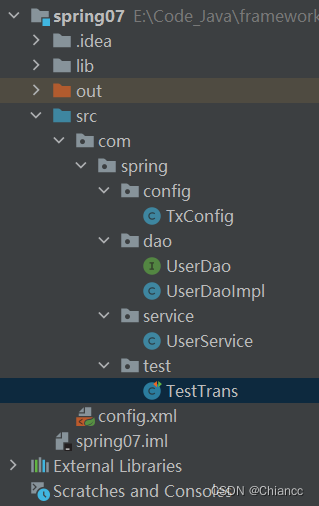Spring5—事务
事务
- 1. 概念
- 2. 转账demo
1. 概念
- 事务是数据库操作最基本单元,逻辑上一组操作,要么都成功,如果有一个失败所有操作都失败。
- 事务四个特性(ACID)
(1)原子性
(2)一致性
(3)隔离性
(4)持久性
2. 转账demo

demo整体结构

- 创建数据库表,并添加记录

- 创建xml配置文件
<beans xmlns="http://www.springframework.org/schema/beans"xmlns:xsi="http://www.w3.org/2001/XMLSchema-instance"xmlns:context="http://www.springframework.org/schema/context"xmlns:tx="http://www.springframework.org/schema/tx"xsi:schemaLocation="http://www.springframework.org/schema/beans http://www.springframework.org/schema/beans/spring-beans.xsd http://www.springframework.org/schema/context http://www.springframework.org/schema/context/spring-context.xsd http://www.springframework.org/schema/tx http://www.springframework.org/schema/tx/spring-tx.xsd"> <context:component-scan base-package="com.spring"></context:component-scan> <bean id="dataSource" class="com.alibaba.druid.pool.DruidDataSource" destroy-method="close"> <property name="url" value="jdbc:mysql:///userdb"/> <property name="username" value="root"/> <property name="password" value="root"/> <property name="driverClassName" value="com.mysql.jdbc.Driver"/> </bean> <bean id="jdbcTemplate" class="org.springframework.jdbc.core.JdbcTemplate"> <property name="dataSource" ref="dataSource"></property> </bean> <bean id="transactionManager" class="org.springframework.jdbc.datasource.DataSourceTransactionManager"> <property name="dataSource" ref="dataSource"></property> </bean> <tx:annotation-driven transaction-manager="transactionManager"></tx:annotation-driven></beans>或者使用全注解开发,创建配置类(作用同xml配置文件)
@Configuration //配置类注解@ComponentScan(basePackages = "com.spring")@EnableTransactionManagement //开启事务public class TxConfig { //创建数据库连接池 @Bean public DruidDataSource getDruidDataSource() { DruidDataSource dataSource = new DruidDataSource(); dataSource.setDriverClassName("com.mysql.jdbc.Driver"); dataSource.setUrl("jdbc:mysql:///userdb"); dataSource.setUsername("root"); dataSource.setPassword("root"); return dataSource; } //创建JdbcTemplate对象 @Bean public JdbcTemplate getJdbcTemplate(DataSource dataSource) { JdbcTemplate jdbcTemplate = new JdbcTemplate(); jdbcTemplate.setDataSource(dataSource); return jdbcTemplate; } //创建事务管理器 @Bean public DataSourceTransactionManager getDataSourceTransactionManager(DataSource dataSource) { DataSourceTransactionManager dataSourceTransactionManager = new DataSourceTransactionManager(); dataSourceTransactionManager.setDataSource(dataSource); return dataSourceTransactionManager; }}- 创建UserDaoImpl.java和UserService.java
UserDaoImpl.java
@Repositorypublic class UserDaoImpl implements UserDao { @Autowired private JdbcTemplate jdbcTemplate; @Override public void add() { String sql = "update t_account set money = money + ? where username = ?"; jdbcTemplate.update(sql, 100, "CLarie"); } @Override public void reduce() { String sql = "update t_account set money = money - ? where username = ?"; jdbcTemplate.update(sql, 100, "Chiancc"); }}UserService.java
@Service@Transactional //开启事务public class UserService { //调用两个方法完成转账 @Autowired private UserDao userDao; public void transfer() { userDao.reduce(); // int i = 2 / 0; userDao.add(); }}- 测试类TestTrans.java
public class TestTrans { @Test public void test() { ApplicationContext context = new ClassPathXmlApplicationContext("config.xml"); //使用xml配置文件 UserService userService = context.getBean("userService", UserService.class); userService.transfer(); } @Test public void test2() { ApplicationContext context = new AnnotationConfigApplicationContext(TxConfig.class); //使用配置类 UserService userService = context.getBean("userService", UserService.class); userService.transfer(); }}

